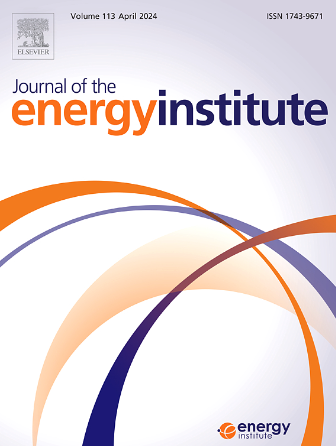Investigation of an optimal exhaust gas recirculation rate on a four-stroke spark-ignited LPG engine
IF 5.6
2区 工程技术
Q2 ENERGY & FUELS
引用次数: 0
Abstract
To determine the optimal exhaust gas recirculation (EGR) rate that can optimize a spark-ignited (SI) liquefied petroleum gas (LPG) engine's performance without compromising emissions, the effects of EGR rates on combustion performance and emission characteristics of a four-stroke SI LPG engine were investigated. Experimental investigations with 0 % and fixed 13.9 % EGR rate were conducted on the SI LPG engine. Afterward, three-dimensional (3D) simulation cases of EGR rates ranging between 0 % and 30 % were modeled while maintaining the SI LPG engine's constant initial operating conditions. Simulation results were validated by the experimental engine results and showed a good agreement. For in-cylinder temperature and pressure, the changes are slightly insensitive between 0 % and 15 % EGR rate resulting to the reduction of engine output power by less than 10.25 %. Between 0 % and 15 %, NOx was significantly reduced, however, an EGR rate of 10 % and 15 % resulted in 1.85g/kWh and 0.83g/kWh NO emissions which are in compliance with NOx Tier III control requirements of the experimental engine. CO emissions were insignificant between 10 % and 15 % EGR rate with an increase of 2.23 %. Soot emissions were significantly lower between 0 % and 15 % EGR rates, but increased sharply at 20 %, 25 %, and 30 % EGR rates by 0.012, 0.022, and 0.028g/kWh respectively which challenges the assumption that SI LPG engines are clean fuels with minimal soot. The results offer valuable insights that promote the use of the EGR strategy at enhancing the SI LPG engine's combustion performance and controlling exhaust emissions.
四冲程火花点火LPG发动机最佳废气再循环速率的研究
为了在不影响排放的前提下优化火花点火(SI)液化石油气(LPG)发动机的性能,确定最佳废气再循环(EGR)速率,研究了EGR速率对四冲程SI LPG发动机燃烧性能和排放特性的影响。在SI LPG发动机上进行了0%和13.9%固定EGR率的实验研究。随后,在保持SI LPG发动机恒定初始运行条件的情况下,对EGR率在0%至30%之间的三维(3D)模拟进行了建模。仿真结果与实验结果吻合较好。对于缸内温度和压力,在0%和15%的EGR率之间的变化略有不敏感,导致发动机输出功率降低不到10.25%。在0%到15%之间,氮氧化物排放量显著减少,但是,10%和15%的EGR率导致1.85g/kWh和0.83g/kWh的NO排放量符合实验发动机的氮氧化物III级控制要求。在10% ~ 15%的EGR率范围内,CO排放量不显著,增加了2.23%。在0%和15%的EGR率下,煤烟排放量显著降低,但在20%、25%和30%的EGR率下,煤烟排放量分别急剧增加0.012、0.022和0.028g/kWh,这挑战了SI LPG发动机是最低煤烟的清洁燃料的假设。研究结果为促进EGR策略在提高SI LPG发动机燃烧性能和控制废气排放方面的应用提供了有价值的见解。
本文章由计算机程序翻译,如有差异,请以英文原文为准。
求助全文
约1分钟内获得全文
求助全文
来源期刊

Journal of The Energy Institute
工程技术-能源与燃料
CiteScore
10.60
自引率
5.30%
发文量
166
审稿时长
16 days
期刊介绍:
The Journal of the Energy Institute provides peer reviewed coverage of original high quality research on energy, engineering and technology.The coverage is broad and the main areas of interest include:
Combustion engineering and associated technologies; process heating; power generation; engines and propulsion; emissions and environmental pollution control; clean coal technologies; carbon abatement technologies
Emissions and environmental pollution control; safety and hazards;
Clean coal technologies; carbon abatement technologies, including carbon capture and storage, CCS;
Petroleum engineering and fuel quality, including storage and transport
Alternative energy sources; biomass utilisation and biomass conversion technologies; energy from waste, incineration and recycling
Energy conversion, energy recovery and energy efficiency; space heating, fuel cells, heat pumps and cooling systems
Energy storage
The journal''s coverage reflects changes in energy technology that result from the transition to more efficient energy production and end use together with reduced carbon emission.
 求助内容:
求助内容: 应助结果提醒方式:
应助结果提醒方式:


